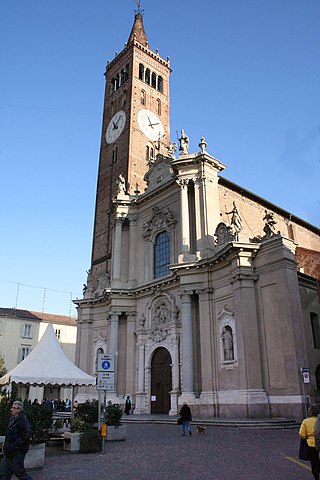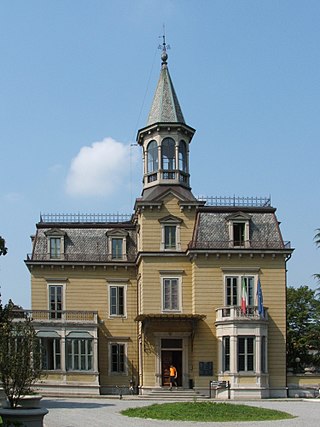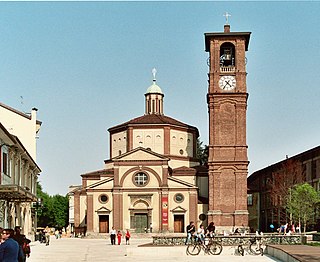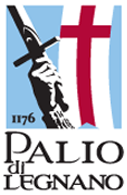Gorgonzola is a town in the Metropolitan City of Milan, Lombardy, northern Italy. It is part of the territory of the Martesana, north-east of Milan. Gorgonzola cheese is named after the town.

The Lombard League was a medieval alliance formed in 1167, supported by the popes, to counter the attempts by the Hohenstaufen Holy Roman emperors to assert influence over the Kingdom of Italy as a part of the Holy Roman Empire. At its apex, it included most of the cities of Northern Italy, but its membership changed with time. With the death of the third and last Hohenstaufen emperor, Frederick II, in 1250, it became obsolete and was disbanded.

Lombard is a language belonging to the Gallo-Italic family and consisting of a cluster of homogeneous dialects spoken by millions of speakers in Northern Italy and Southern Switzerland, including most of Lombardy and some areas of the neighbouring regions, notably the eastern side of Piedmont and the western side of Trentino, and in Switzerland in the cantons of Ticino and Graubünden. It is also spoken in Santa Catarina in Brazil by Lombard immigrants from the Province of Bergamo.

The Battle of Legnano was a battle between the imperial army of Frederick Barbarossa and the troops of the Lombard League on May 29, 1176, near the town of Legnano in present-day Lombardy, in Italy. Although the presence of the enemy nearby was already known to both sides, they suddenly met without having time to plan any strategy.

Legnano is an Italian town and comune in the north-westernmost part of the Province of Milan, about 20 kilometres (12 mi) from central Milan. With 60,259, it is the thirteenth-most populous township in Lombardy. Legnano is located in the Alto Milanese and is crossed by the Olona river.

Treviglio is a town and comune in the province of Bergamo, in Lombardy, Northern Italy. It lies 20 kilometres south of the province capital, in the lower territory called "Bassa Bergamasca".

A carroccio was a large four-wheeled wagon bearing the city signs around which the militia of the medieval communes gathered and fought. It was particularly common among the Lombard, Tuscan and, more generally, northern Italian municipalities. Later its use spread even outside Italy. It was the symbol of municipal autonomy. Priests celebrated Mass at the altar before the battle, and the trumpeters beside them encouraged the fighters to the fray.

Aribert was the archbishop of Milan from 1018, a quarrelsome warrior-bishop in an age in which such figures were not uncommon.

Alberto da Giussano is a legendary character of the 12th century who would have participated, as a protagonist, in the battle of Legnano on 29 May 1176. In reality, according to historians, the actual military leader of the Lombard League in the famous military battle with Frederick Barbarossa was Guido da Landriano. Historical analyses made over time have indeed shown that the figure of Alberto da Giussano never existed.

Pontida is a comune (municipality) in the Province of Bergamo in the Italian region of Lombardy, located about 40 kilometres (25 mi) northeast of Milan and about 13 kilometres (8 mi) northwest of Bergamo. As of 31 December 2004, it had a population of 3,112 and an area of 10.1 square kilometres (3.9 sq mi).

Zanica is a comune (municipality) of around 8,804 inhabitants in the Province of Bergamo in the Italian region of Lombardy, located about 45 kilometres (28 mi) northeast of Milan and 7 kilometres (4 mi) south of Bergamo. Zanica borders the following municipalities: Azzano San Paolo, Cavernago, Comun Nuovo, Grassobbio, Orio al Serio, Stezzano, Urgnano.
Laudes Mediolanensis civitatis, also known as the Versum de Mediolano civitate or Versus in laudem mediolanensis civitatis, is an early medieval Latin poem, which describes and praises the Italian city of Milan. It dates from the mid-8th century, during the era of the Lombard Kingdom. The poet is unknown. The poem is an encomium, an example of the urban eulogy genre. It celebrates not only the Christian heritage of Milan, but also its pagan Roman history. It is considered to be the earliest surviving medieval description of a city. The poem served as a model for the Carolingian Versus de Verona, a similar encomium to its rival Verona, written around 50 years later.

The Company of Death is the name used in the historical literature of English language for two related chosen tactical corps, two selected bands of warriors, entrusted to guarantee the cohesiveness and efficiency in battle of both the Milanese and Lombard League's militias through their bond by oath to the defence of the Milanese Carroccio, the wagon on which the standard of the Lombard allies stood.

The Basilica of Saint Magnus is the principal church of the Italian town of Legnano, in the Province of Milan. It is dedicated to the Saint Magnus, who was Archbishop of Milan from 518 to 530. The church was built from 1504 to 1513 in the Renaissance-style designed by Donato Bramante. The bell tower was added between the years 1752 and 1791. On 18 March 1950, Pope Pius XII named the Basilica of San Magno a minor basilica.

The Palio di Legnano is a traditional event generally held on the last Sunday of May in the City Of Legnano, Italy, to recall the Battle of Legnano held on 29 May 1176 by the Lombard League and the Holy Roman Empire of Frederick Barbarossa. This Palio is composed by a medieval pageant and a horse race. Until 2005 the whole event was named Sagra del Carroccio.
Guido da Landriano, or Landriani, was an Italian condottiero and politician. He held the position of consul of the city of Milan and was the military leader of the troops of the Lombard League during the battle of Legnano. Alberto da Giussano, who according to tradition, was in command of the Lombard League, is in fact a legendary figure.

Lombard nationalism is a nationalist, but primarily regionalist, movement active primarily in Lombardy, Italy. It seeks more autonomy or even independence from Italy for Lombardy and, possibly, all the lands that are linguistically or historically Lombard. During the 1990s, it was strictly connected with Padanian nationalism.

Legnano, an Italian municipality of the Metropolitan City of Milan in the Alto Milanese, has a recorded history from the first mention of the Legnarello district to the present day.

The 73rd Infantry Regiment "Lombardia" is an inactive unit of the Italian Army last based in Arzene. The regiment is named for the region of Lombardy and part of the Italian Army's infantry arm.
Giuseppe Antonio Sassi, in Latin Saxius (1675-1751), was an Italian librarian and literary scholar.




















